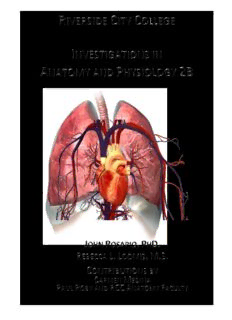
RCC Anat 2b lab manual 2017 NA PDF
Preview RCC Anat 2b lab manual 2017 NA
ANATOMY AND PHYSIOLOGY 2B—REBECCA LOOMIS Page 1 C ONTENTS LABORATORY PAGE NO. LAB 1 Neurons 3 LAB 2 Neurophysiology 15 LAB 3 The Spinal Cord and Spinal Cord Tracts 21 LAB 4 Brain Anatomy 30 LAB 5 Sagittal Section of the Brain 41 LAB 6 Nerve Structure 48 LAB 7 Cranial Nerves 51 LAB 8 Brachial Plexus 57 LAB 9 Lumbosacral Plexus 61 LAB 10 Nervous System Tracts 70 LAB 11 The Endocrine System 75 LAB 12 Blood Components 82 LAB 13 The Cardiovascular System–Blood Vessels 90 LAB 14 The Cardiovascular System–The Heart 99 LAB 15 Heart Function and Conduction 109 LAB 16 The Respiratory System 119 LAB 17 Respiratory Lung Volumes 133 LAB 18 The Urinary System 139 LAB 19 Urinalysis 149 LAB 20 The Digestive System 153 LAB 21 The Reproductive System 169 Answer Key 184 ANATOMY AND PHYSIOLOGY 2B—REBECCA LOOMIS Page 2 OBJECTIVE To learn about the important structural components of a neuron and relate each to a functional role. PART A—NEURON STRUCTURE Study the laboratory models and diagrams in your text to identify the following structures. Write a brief definition or description of each item. a. cyton (cell body, soma) b. dendrite c. Nissl body d. nucleus e. axon hillock f. axon g. myelin h. neurilemma and Schwann cell nucleus i. Schwann cell j. node of Ranvier k. axolemma l. collateral axon m. axon terminal or synaptic knob n. vesicles ANATOMY AND PHYSIOLOGY 2B—REBECCA LOOMIS Page 3 PART B—CLASSIFICATION OF NEURONS OBJECTIVE To classify neurons structurally and functionally. Neurons can be categorized either by their appearance (structural) or by what they do (functional). View the laboratory models, consult your textbook, lecture notes, talk to your colleagues, and then complete the chart below. STRUCTURAL TYPES NO. OF PROCESSES LOCATION (CNS/PNS) SPECIFIC LOCATION 1. 2. 3. FUNCTIONAL TYPES 1. 2. 3. PART C—NEURON QUESTIONS Answer the following questions to determine what you have learned. 1. The nucleus of a neuron is located in the . 2. Myelin is made of the membranes of . 3. carry impulses away from the cell body of a neuron. 4. neurons are always sensory. 5. neurons can be found in the retina of the eye. 6. Schwann cells are only found in the nervous system. 7. Myelin conduction velocity. 8. The is an interruption in the myelin sheath which enhances conduction velocity by allowing saltatory conduction. 9. Membranes and therefore myelin are made of and . ANATOMY AND PHYSIOLOGY 2B—REBECCA LOOMIS Page 4 10. Vesicles are membrane-bound sacs that contain . 11. The cell bodies of neurons often cluster together. Clusters of cells bodies in the CNS are called .and in the PNS these clusters are called . 12. Synonyms for sensory and motor are and . 13. Nissl bodies are clusters of responsible for synthesis of . PART D—MULTIPOLAR NEURON Label the indicated structures on the typical multipolar neuron diagram below. 1 2 4 3 6 9 5 7 10 8 11 12 13 14 ANATOMY AND PHYSIOLOGY 2B—REBECCA LOOMIS Page 5 PART E—MULTIPOLAR NEURON QUESTIONS 1. What is the outer membrane of structure #8 called? 2. What is contained in the vesicles in structure #15? 3. What cell forms the myelin sheath in the PNS? CNS? 4. What is structure #3 composed of? 5. What is the function of regions such as #11? 6. What is the significance of region #6? 7. Draw how a bipolar neuron would differ from this one. 8. Draw how a unipolar neuron would differ from this one. ANATOMY AND PHYSIOLOGY 2B—REBECCA LOOMIS Page 6 PART F—MULTIPOLAR MOTOR NEURON SLIDE Observe under the microscope the slide of a multipolar motor neuron and draw what you see in the space below. Label the following structures: axon, cell body, dendrite, nucleus, Nissl bodies, and glial cells. PART G—NEUROGLIAL CELLS OBJECTIVE To learn about the different types of glial cells. Neuroglial cells protect, nurture, and support neurons but they do not conduct electricity like neurons. Complete the table below as you learn about the neuroglia. TYPE CNS/PNS FUNCTION 1. 2. 3. 4. 5. 6. ANATOMY AND PHYSIOLOGY 2B—REBECCA LOOMIS Page 7 PART H—NEURON PHYSIOLOGY OBJECTIVE To learn about electrical potentials including the membrane potential and the action potential. Check out a laptop and work as a group. Go to www.interactivephysiology.com and enter your login information. If you do not have a log in you may access the same tutorials at nedbook.adam.com/pages/IPWeb/home/index2.html to begin. Open the Nervous System I interactive tutorial. ANATOMY AND PHYSIOLOGY 2B—REBECCA LOOMIS Page 8 Work through these topics: Membrane Potentials, The Action Potential and Ion Channels. QUESTIONS (Answer these questions as you view the tutorials.) 1. What is an ion? 2. Can ions move in and out of cells? 3. How do ions move in and out of cells? 4. What is an ion channel? 5. What factors determine in which direction ions will move through an open channel? 6. What two factors contribute to the existence of a resting membrane potential? 7. What maintains the concentration gradients of Na+ and K+ across the membrane and how is this achieved? ANATOMY AND PHYSIOLOGY 2B—REBECCA LOOMIS Page 9 Dendrites N ucleus Nucleolus Cell body Ni ssl bodies Axo n hillock Axon Schwann cell Neurilemma Schwann cell nucleus Axolemma Axon terminals Node of Ranvier Axon collateral Telodendria ANATOMY AND PHYSIOLOGY 2B—REBECCA LOOMIS Page 10
Description: